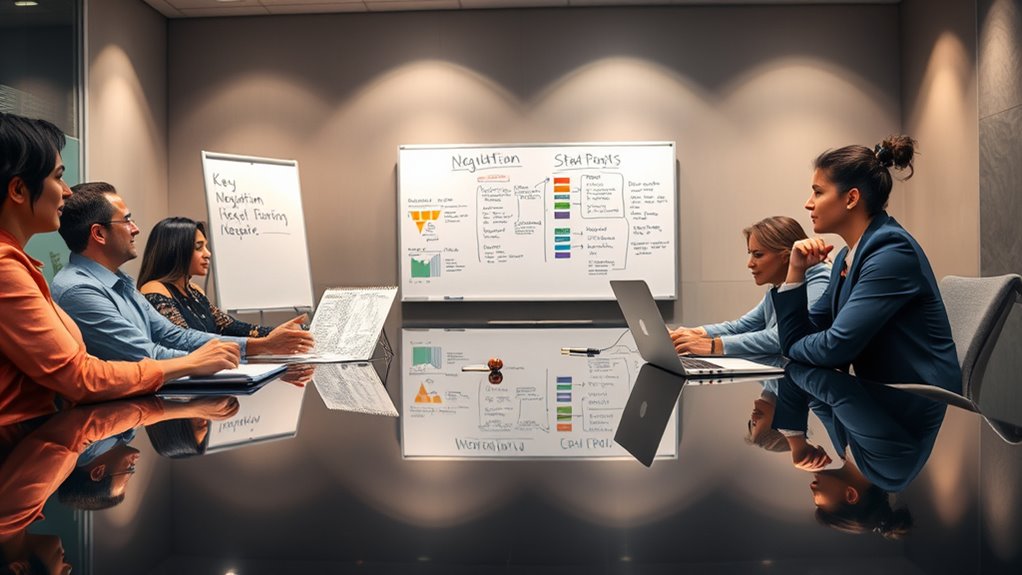To achieve business success, focus on establishing rapport and trust through non-verbal cues and open communication. Prepare thoroughly by understanding your goals and the other party’s interests. Use active listening and collaborative language to foster cooperation. Adopt creative solutions while clearly articulating your position with confidence. Tailor your strategies to the negotiation type, whether it’s integrative or distributive. By implementing these tactics, you’ll strengthen your negotiation skills and further enhance your outcomes in future discussions.
Key Takeaways
- Build rapport and trust through active listening, eye contact, and small talk to foster stronger connections.
- Prepare thoroughly by gathering information on market trends and understanding the other party’s priorities and decision-making process.
- Use collaborative language and emotional intelligence to emphasize shared goals and navigate feelings during discussions.
- Develop a comprehensive strategy with clear objectives, target terms, and potential concessions while remaining flexible to adapt.
- Engage in joint brainstorming to explore creative solutions, balancing assertive communication with a collaborative approach for mutual benefits.
Building Rapport and Trust in Negotiations

Building rapport and trust is essential for successful negotiations. You can start by using non-verbal cues like mimicking gestures and maintaining eye contact.
Face-to-face meetings are more effective than digital interactions, so prioritize in-person conversations. Discover common interests through small talk or background research; this connection can enhance your relationship.
Prioritize in-person conversations to strengthen relationships by discovering common interests through small talk and background research.
Thoughtful gestures, like remembering personal details, show you care. Self-disclosure about your experiences can reveal shared values and foster open communication.
To establish trust, be transparent about your goals and consistently fulfill commitments. Practice active listening, acknowledge feelings, and communicate respectfully.
Strategic Communication Techniques

Start by practicing active listening to understand the other party’s priorities and concerns, creating a collaborative atmosphere. Use collaborative language that emphasizes shared goals and fosters cooperation. Open and honest communication builds trust, while nonverbal cues like mirroring body language help establish rapport.
Cultivate emotional intelligence to navigate feelings and enhance empathy during discussions. Clearly articulate your position and maintain transparency about your interests and expectations. Be assertive without being aggressive, and adapt your communication style to suit different counterparts.
Lastly, create a feedback loop to continuously refine your communication skills and ensure effective dialogue throughout the negotiation process. Additionally, understanding sustainable fashion trends can provide valuable context when negotiating with brands focused on eco-conscious practices.
Essential Negotiation Preparation Steps

Effective negotiation preparation can significantly impact your success at the bargaining table. Start by gathering essential information; research market trends, industry benchmarks, and financial data to understand the landscape.
Analyze your counterparty’s background, priorities, and decision-making process, as this insight will tailor your strategy effectively. Next, set clear objectives by defining your goals and ranking them by importance, while identifying non-negotiables.
Develop a solid negotiation strategy with a comprehensive action plan that includes target terms and potential concessions. Prepare for dynamics by role-playing scenarios, managing your emotions, and anticipating challenges.
Lastly, have backup plans ready to ensure you can adapt to unexpected developments during negotiations.
Effective Negotiation Techniques for Success

In negotiation, adopting a collaborative solutions approach can help you find creative ways to meet both parties’ needs.
Pair that with assertive communication strategies to express your views confidently while maintaining respect.
This combination not only fosters understanding but also paves the way for successful outcomes.
Collaborative Solutions Approach
When you adopt a collaborative solutions approach in negotiation, you’re not just seeking agreements; you’re building relationships that can withstand the test of time. This method emphasizes open communication and active listening, ensuring both parties feel heard and respected.
By focusing on shared interests, you transform negotiations into joint problem-solving sessions, leading to creative and mutually beneficial outcomes. Establishing trust is crucial; it lays the foundation for enduring partnerships. Engaging in joint brainstorming to explore innovative solutions and maintaining flexibility, adjusting agreements as needed, can also be enhanced by understanding business startup essentials, which provide a solid framework for your negotiations. Regular feedback and thorough preparation help align priorities and address issues early on, minimizing conflict and enhancing overall communication.
Embrace this approach, and you’ll cultivate strong, lasting business relationships.
Assertive Communication Strategies
Negotiators often find that assertive communication is key to achieving success. This approach balances confidence with respect for others’ perspectives, allowing you to express your needs and boundaries clearly.
Remember, being assertive isn’t aggressive; it’s about ensuring your interests are represented while fostering mutual understanding. Preparation plays a crucial role, so research the other party’s priorities and gather relevant data to strengthen your position.
Employ active listening and emotional intelligence to read the room and respond effectively. Use “I” statements to express yourself without sounding accusatory, and maintain assertive body language, like eye contact.
Negotiation Strategies Tailored for Small Businesses

Successful negotiations are essential for small businesses aiming to thrive in competitive markets. Start by conducting thorough research on your counterpart’s interests and market trends. Define your goals clearly to guide the negotiation process effectively.
Anticipate objections, allowing you to craft persuasive arguments. Building relationships is vital; focus on rapport, active listening, and open communication to foster trust. Be flexible and adaptable, exploring creative solutions that satisfy both parties.
Clearly articulate your position while being mindful of non-verbal cues. Remember to summarize agreements to avoid misunderstandings.
Lastly, don’t hesitate to make tactical concessions or use silence strategically, as these tactics can lead to more favorable outcomes. Your success lies in preparation, communication, and a willingness to collaborate.
Understanding Different Types of Business Negotiations

Understanding the different types of business negotiations is crucial for achieving favorable outcomes.
Grasping the various types of business negotiations is essential for securing successful results.
You’ll encounter distributive negotiations, where one party wins at the other’s expense, and integrative negotiations, which aim for win-win solutions.
Principled negotiations focus on mutual interests, while team negotiations involve multiple representatives from each side.
Multiparty negotiations include more than two parties collaborating.
You might also face competitive negotiations that prioritize advantageous deals, or compromising negotiations seeking middle ground.
Power-based negotiations leverage strength to dictate terms, whereas adversarial negotiations often feel confrontational.
One-shot negotiations focus on single deals without future interactions.
Frequently Asked Questions
What Are Common Negotiation Mistakes to Avoid?
When you’re negotiating, avoid common mistakes like inadequate preparation and emotional responses.
Don’t rush into discussions without understanding the other party’s background or defining your objectives.
Stay calm and listen more than you talk to foster cooperation.
Focus on collaborative solutions rather than just price, and make sure to read contracts carefully before signing.
Lastly, recognize hard-bargaining tactics to maintain a productive negotiation environment.
How Do Cultural Differences Impact Negotiation Styles?
Cultural differences shape negotiation styles significantly.
When you engage with someone from a different background, you might notice variations in communication, such as direct vs. indirect approaches. These differences affect how you present ideas and interpret responses.
Additionally, attitudes towards risk and time can influence the negotiation pace. By being aware of these cultural nuances, you can adapt your style, fostering better understanding and collaboration during negotiations, ultimately leading to more successful outcomes.
What Role Does Body Language Play in Negotiations?
Body language in negotiations is like a silent orchestra, playing melodies that words alone can’t convey.
When you maintain eye contact and use open gestures, you’re building bridges of trust. Your posture and facial expressions can reveal your confidence or uncertainty, guiding the conversation’s flow.
How Can I Manage Stress During Negotiations?
To manage stress during negotiations, start by preparing thoroughly. Research the other party to anticipate their responses. Set clear objectives to maintain focus and confidence.
Understand your BATNA to feel secure about alternatives. Use breathing exercises and visualization to calm your mind. If things get tense, take breaks to regroup.
Prioritize rest and nutrition beforehand, and keep a positive attitude to channel anxiety into excitement for the process ahead.
What Should I Do if Negotiations Break Down?
When negotiations hit a wall, it’s like trying to unlock a rusty old door.
First, you need to identify what went wrong. Re-evaluate your best alternative and assess your communication’s clarity.
Taking a timeout can help you regroup and rethink your strategy. If needed, consider involving a mediator.
Rebuilding trust is crucial, so acknowledge mistakes, show empathy, and maintain open communication to pave the way for future discussions.
Conclusion
In the end, you might think that mastering negotiation tactics guarantees success, but it’s often the unexpected moments that seal the deal. It’s not just about strategies and preparation; sometimes, a genuine laugh or shared coffee can turn a tense negotiation into a partnership. So, while you’re busy planning your next big pitch, remember that the best outcomes often come from the simplest connections. Who knew that a little humanity could be your strongest weapon?










